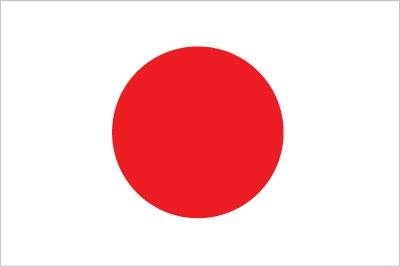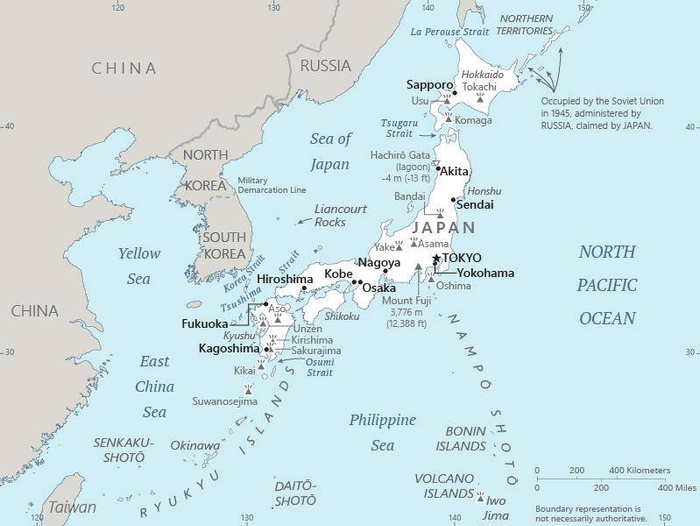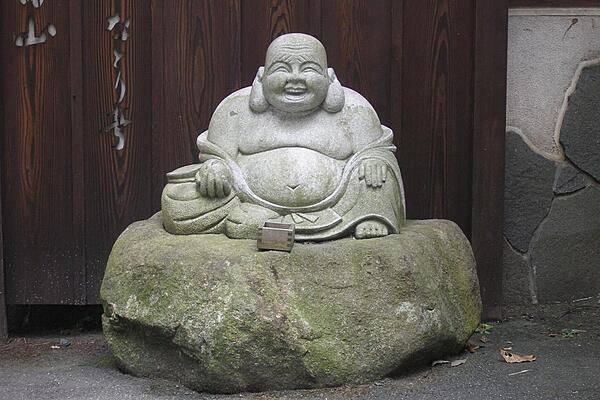145 Japan

White with a large red disk (representing the sun without rays) in the center.
Flag courtesy of the CIA World Factbook

Map courtesy of the CIA World Factbook

A Laughing Buddha in Narita.
Photo courtesy of the CIA World Factbook
Government
According to Britannica, Japan’s constitution was promulgated in 1946 and came into force in 1947, superseding the Meiji Constitution of 1889. It differs from the earlier document in two fundamental ways: the principle of sovereignty and the stated aim of maintaining Japan as a peaceful and democratic country in perpetuity. The emperor, rather than being the embodiment of all sovereign authority (as he was previously), is the symbol of the state and of the unity of the people, while sovereign power rests with the people (whose fundamental human rights are explicitly guaranteed). Article 9 of the constitution states that Japan “forever renounces war as a sovereign right of the nation”, a clause that has been much debated since the constitution’s promulgation.
The government is now based on a constitution that stipulates the separation of powers between the legislative, executive, and judicial branches. The emperor’s major role now consists of such formalities as appointing the prime minister, who is first designated by the Diet (Kokkai), and appointing the chief justice of the Supreme Court (Saikō Saibansho), convoking sessions of the Diet, promulgating laws and treaties, and awarding state honors, all with the advice and approval of the cabinet (naikaku).
Legislative powers are vested in the Diet, which is popularly elected and consists of two houses. The House of Representatives (Shūgiin), or lower house, ultimately takes precedence over the House of Councillors (Sangiin), or upper house, in matters of passing legislation, controlling the budget, and approving treaties with foreign powers. Executive power is vested in the cabinet, which is organized and headed by the prime minister, though formally appointed by the House of Representatives. If the House of Representatives passes a resolution of no confidence or refuses to pass a vote of confidence in the government, the cabinet must resign, unless the House of Representatives is dissolved within 10 days of such action. There are governmental ministries and agencies in addition to the Prime Minister’s Office. All offices of the central government are located in and around the Kasumigaseki district in central Tokyo. An independent constitutional body called the Board of Audit is responsible for the annual auditing of the accounts of the state.
The 1947 constitution establishes the principle of autonomy for local public entities. Significant powers are allotted to local assemblies, which are elected by direct public vote, as are their chief executive officers. Many matters related to labor, education, social welfare, and health, as well as land preservation and development, disaster prevention, and pollution control, are dealt with by local governing bodies.
Japan is divided into 47 prefectures, 43 of which are ken (prefectures proper); of the remainder, Tokyo is a to (metropolitan prefecture), Hokkaido is a dō (district), and Ōsaka and Kyōto are fu (urban prefectures). Prefectures, which are administered by governors and assemblies, vary considerably both in area and in population. The largest prefecture is Hokkaido, with an area of 32,221 square miles (83,453 square km), while the smallest is Kagawa, with 724 square miles (1,876 square km). The population of Tokyo, the most populous prefecture, is some 20 times greater than that of Tottori, the least populous. An intermediate level of governmental services is formed between the central and prefecture levels. The branch offices of several central ministries are located in certain cities, which, as regional centers, generally administer several prefectures together.
Prefectures are further subdivided into minor civil divisions; these include shi (cities), machi or chō (towns), and mura or son (villages). All these local government units have their own mayors, or chiefs, and assemblies. In addition, a city that has a population of at least 500,000 can be given the status of shitei toshi (designated city). Designated cities are divided into ku (wards), each of which has a chief and an assembly, the former being nominated by the mayor and the latter elected by the residents. The number of these cities has steadily increased since the first five (Yokohama, Ōsaka, Nagoya, Kyōto, and Kōbe) were named in the mid-1950s. Tokyo has 23 tokubetsu ku (special wards), the chiefs of which are elected by the residents. These special wards, created after the metropolitan prefecture was established in 1943, demarcate the city of Tokyo from the other cities and towns that make up the metropolitan prefecture; the city proper, however, no longer exists as an administrative unit.
The judiciary is completely independent of the executive and legislative branches of the government. The judicial system consists of three levels: the Supreme Court, eight high (appellate) courts, and a district court and a family court in each prefecture (except for Hokkaido, which has four). In addition, there are many summary (informal) courts, which hear cases for some minor offenses or those involving small sums of money. Other than those minor cases, district and family courts are the courts of first instance, except for cases involving insurrection, which are tried in the high courts.
The Supreme Court consists of a chief justice and 14 other justices. The chief justice is appointed by the emperor upon designation by the cabinet, while the other justices are appointed by the cabinet. The appointment of the justices of the Supreme Court is subject to review in a national referendum, first at the time of the general election following their appointment and then at the general election every 10 years thereafter. An impeachment system also exists; the court of impeachment consists of members of the House of Representatives and of the House of Councillors. The Supreme Court is the body of final review, and its rulings set the precedent for all final decisions in the administration of justice. The Supreme Court also exercises the power of judicial review, enabling it to determine the constitutionality of any law, order, regulation, or official act. Lower-court judges are appointed by the cabinet from a list of persons nominated by the Supreme Court. The appointment term is for 10 years, and reappointment is allowed. All judges of lower courts are required by law to retire at the age of 70.
Civil Aviation Bureau
The Ministry of Land, Infrastructure, Transport and Tourism is a government agency responsible for the comprehensive and systematic use, development and conservation of national land, the consistent development of social infrastructure for this purpose, the promotion of transportation policies, the development of meteorological services, and the ensuring of maritime safety and security. It was established on January 6, 2001 as part of the reform of central ministries and agencies, with the former four ministries (Hokkaido Development Agency, National Land Agency, and Ministry of Transport and Construction) as the parent body. The Civil Aviation Bureau conducts the following activities:
1) inspections of aircraft and equipment,
2) checks of the operation and maintenance systems of the air carriers,
3) confirmation of the competency of aviation personnel, such as pilots and mechanics, through examinations and other checks, and
4) ramp inspections of foreign registered aircraft at airports in Japan.
Airspace
SkyVector – Google Maps – ADS-B Exchange
ICAO countries publish an Aeronautical Information Publication (AIP). This document is divided into three parts: General (GEN), En Route (ENR) and Aerodromes (AD). ENR 1.4 details the types of airspace classes they chose to adopt from classes A through G.
Japan AIP (requires user name and password).
Drone Regulations
Flight Rules for Unmanned Aircraft(Drones and Model Aircraft, etc.)
National Police Agency – The Drone Act
Advanced Air Mobility (AAM) Regulations & Policies
2021 – Advanced Air Mobility
2022 – The Osaka Edition Roadmap and the Action Plan toward the Social Implementation of the Air Mobility Revolution
2023 – Concept of Operations for Advanced Air Mobility (ConOps for AAM)
2023 – MLIT
2023 – Concept of Operations for Advanced Air Mobility (ConOps for AAM) in Japan – by Shinichiro Tsuri
2024 – Rulemaking Activities for Advanced Air Mobility (AAM) in Japan – by Shinichiro Tsuri
2024 – Policy of special conditions application for electric vertical take-off and landing aircraft
Bilateral agreements facilitate the reciprocal airworthiness certification of civil aeronautical products imported/exported between two signatory countries. A Bilateral Airworthiness Agreement (BAA) or Bilateral Aviation Safety Agreement (BASA) with Implementation Procedures for Airworthiness (IPA) provides for airworthiness technical cooperation between the FAA and its counterpart civil aviation authorities.
Bilateral Aviation Safety Agreement – Executive Agreement
Declaration of Cooperation in Advanced Air Mobility
2016 Notification of Policy Deviation Memorandum for FAA Order 8130.21H
IPA Revision 1
Obtaining Certification Approval from this Country
Advanced Air Mobility (AAM) News
2025 – Tokyo taps SkyDrive, Joby for eVTOL project
2025 – The Flying Car Revolution: How Banpaku 2025 Accelerated Japan’s eVTOL Industry
2025 – Archer, Soracle partner on air taxi services in Japan
2025 – In Japan, World Expo Visitors Are Getting Their First Glimpse of New eVTOL Aircraft
2025 – SkyDrive exhibits eVTOL, rail routes in Japanese city
2025
Video courtesy of Advanced Air Mobility Institute from the July 2025 Global AAM Forum.
2025 – SkyDrive, PT Whitesky plan eVTOL operations in Indonesia
2025 – ANA Holdings, Joby Aviation expand partnership in Japan
2025 – SkyDrive conducts demo flight in Japan (VIDEO)
2025 – SkyDrive to perform demonstration flights at Osaka Expo 2025
2025 – Railway Companies Back SkyDrive’s Plans for eVTOL Air Taxis
2025 – ARC Aerosystems Partnership to Accelerate VTOL Introduction in Japan
2025 – SkyDrive receives funding from railways, bank
2025 – SkyDrive Picks Stirling Dynamics To Supply eVTOL Pilot Control Sticks
2025 – Wisk, JAL Engineering partner on AAM in Japanese city
2025 – Joby Aviation closes on $250M investment from Toyota Motor
2025 – Japan, Singapore to partner on AAM, strengthen aviation safety
2025 – Hexa eVTOL Aircraft Suffers Rotor Failure at Osaka World Expo
2025 – SkyDrive brings full-scale eVTOL mock-up to Japanese expo
2025 – LIFT Aircraft demos HEXA eVTOL aircraft in Japan
2025 – SkyDrive Flies eVTOL Air Taxi Prototype in Osaka
2025 – UAS, UAM, AAM research papers sought for Japan Drone 2025
2025 – SkyDrive releases footage from recent test flights (VIDEO)
2025 – OSAKAKO Vertiport Completes Construction to Support SkyDrive eVTOL Demonstrations at Expo 2025
2025 – ASKA Collaborates to Explore Hybrid VTOL Integration in Japan
2025 – Osaka Metro opens new vertiport for Expo 2025 in Japan (VIDEO)
2025 – In Japan, New eVTOL Aircraft Are Seen As a Way to Improve Public Transportation
2025 – JCAB issues G-1 certification basis for SkyDrive eVTOL aircraft
2025 – SkyDrive, Kyushu Railway Company plan eVTOL network in Oita, Japan
2025
Video courtesy of Advanced Air Mobility Institute from the January 2025 Global AAM Forum. Complete session for Day 3 of this Forum is available on the Advanced Air Mobility Institute YouTube Channel
2024 – SkyDrive, Osaka Metro to develop eVTOL routes in Japan
2024 – AutoFlight’s eVTOL Flies in Japan
2024 – SkyDrive and JTB sign agreement to explore eVTOL tourism services and revitalize local communities
2024 – AutoFlight achieves historic first flight in Japan
2024 – CAAS, JCAB to collaborate on developing UAS, AAM regulations
2024 – Archer Inks Deal With Soracle To Bring Electric Air Taxis To Japan
2024 – Toyota and Joby complete first air taxi flight in Japan
2024 – SkyDrive raises new funding for eVTOL development, certification
2024 – Osaka Metro, SkyDrive to study eVTOL operations in Japan
2024 – Joby seeks eVTOL aircraft certification in Australia, Japan, UK
2024 – Japan’s SkyDrive sees market for lighter, short-range air taxis
2024 – Japan’s Setouchi Community plan to build AAM network from Osaka to Kita Kyushu by 2028
2024 – SkyDrive to Conduct eVTOL Implementation Study in Japan
2024 – MOL Switch invests in electric seaglider developer Regent
2024 – FAA accepts SkyDrive’s eVTOL certification application
2024 – AutoFlight Delivers Prosperity Air Taxi To Japanese Operator
2024 – EHang Announces Japan’s First UAM Center in Tsukuba
2024 – SkyDrive Begins Production of Revolutionary eVTOL Aircraft with Suzuki
2024 – Eve Air Mobility and SkyScape announce first urban ATM agreement in Japan
2023 – Californian eVTOL Maker Gearing Up for Air Taxi Services Across Japan
2023 – Joby, ANA Holdings Partner with Nomura Real Estate Development for Vertiports in Japan
2023 – SkyDrive Secures $83M Innovation Grant to Propel Aerial Mobility in Japan
2023 – eVTOLs set to be big in Japan?
2023 – SkyScape to develop vertiports for eVTOL operations in Japan
2023 – SkyDrive to participate in Smart Mobility Expo project at 2025 World Expo in Osaka, Japan
2023 – SkyDrive to identify vertiports, flight routes for 2025 Osaka Kansai Expo
2023 – Wisk Aero and Japan Airlines partner for future AAM operations
2023 – EHang inducted into Japan’s Public-Private Committee for Advanced Air Mobility
2023 – LIFT Aircraft completes piloted eVTOL demonstrations in Japan
2023 – EH216 AAV Completes Its Japan’s First Passenger-Carrying Demo Flight
Short Essay Questions
Scenario-Based Question
You have been hired by a Drone Startup Company. Your boss has immediately assigned this job to you.
They need you to prepare a one-page memo detailing the legalities of using a drone to film in Narita.
They need you to mention any national laws and local ordinances.
They specifically want to know what airspace (insert pictures) you will be operating in and whether or not you need an airspace authorization.
Does it matter whether or not you are a citizen of the country?
Lastly, there is a bonus for you if, as you scroll through this chapter, you find any typos or broken links!
Short Essay Questions
- What are the drone categories?
- How is registration addressed?
- How is remote ID addressed?
- What are the model aircraft rules?
- What are the commercial drone rules?
- Are there waivers or exemptions to the rules? If so, for what?
- Would you share a link to an interactive airspace map?
- How is BVLOS addressed?
- How can you fly drones at night?
- How can you fly drones over people?
- Where do you find drone NOTAMs?
- What are the rules for drone maintenance?
- What are the rules for an SMS program?
- What are some unique rules not mentioned above?
- What are the C-UAS rules?
- What are the AAM rules?

